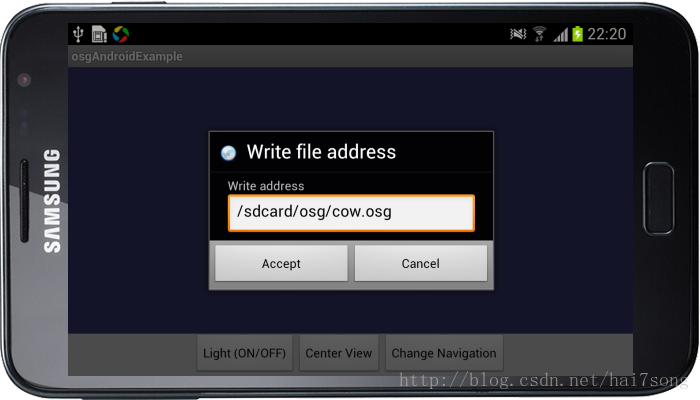osg for android学习之一:windows下编译(亲测通过)【转】
1. 首先需要一个OSG for android的环境
(1)NDK 现在Eclipse 对NDK已经相当友好了,已经不需要另外cygwin的参与,具体可以参考
Android NDK开发篇(一):新版NDK环境搭建(免Cygwin,超级快)
(2).OSG for android的编译,参考 osg for android学习之一:windows下编译(亲测通过) 建议编译OpenGL ES2版本.
2.然后加载OSG自带的Example:osgAndroidExampleGLES2
(1)点击菜单键加载文件路径,输入/sdcard/osg/cow.osg(必须先往sdcard创建文件夹osg并把cow.osg放到该文件夹里边)
(2)接着经典的牛出现了:)
3.自带的example太多的代码,这样的代码无论对于NDK的初学者或OSG很不直观,所以本人重写了一个HelloWolrd for
osg的例子。例子很简单,就是简单加载一个四边形并附上颜色。
(1)java代码
|
1
2 3 4 5 6 7 8 9 10 11 12 13 14 15 16 17 18 19 20 21 22 23 24 25 26 27 28 29 |
package com.example.helloosg;
import javax.microedition.khronos.egl.EGLConfig; import javax.microedition.khronos.opengles.GL10; import android.opengl.GLSurfaceView.Renderer; public class NDKRenderer implements Renderer{ NDKRenderer(){ @Override @Override |
|
1
2 3 4 5 6 7 8 9 10 11 12 13 14 15 |
package com.example.helloosg;
public class osgNativeLib { static { System.loadLibrary("osgNativeLib"); } /** |
|
1
2 3 4 5 6 7 8 9 10 11 12 13 14 15 16 17 18 19 20 21 22 23 24 25 26 27 28 29 30 31 32 33 34 35 36 37 38 39 40 41 42 43 44 45 46 47 48 49 50 51 52 53 54 55 56 57 |
package com.example.helloosg;
import android.app.Activity; public class MainActivity extends Activity { private GLSurfaceView mGLSurfaceView; @Override @Override @Override @Override |
(2)JNI代码
|
1
2 3 4 5 6 7 8 9 10 11 12 13 14 15 16 17 18 19 20 21 22 23 24 25 26 27 28 29 30 31 32 33 34 35 36 37 38 39 40 41 42 43 44 45 46 47 48 49 50 51 52 53 54 55 56 57 58 59 60 61 62 63 64 65 66 67 68 69 70 71 72 73 74 75 76 77 78 79 80 81 82 83 84 85 86 87 88 89 90 91 92 93 94 95 96 97 98 99 100 101 102 103 104 105 106 107 108 109 110 111 112 113 114 115 116 117 118 119 120 121 122 123 124 125 126 127 128 129 130 131 132 133 134 135 136 137 138 139 |
/ * Created on: 2014-10-19
* Author: VCC */ #include "OsgMainApp.h" OsgMainApp::OsgMainApp() { void OsgMainApp::initOsgWindow(int x, int y, int width, int height) { _viewer = new osgViewer::Viewer(); _root = new osg::Group(); _viewer->realize(); _manipulator = new osgGA::KeySwitchMatrixManipulator; _viewer->getViewerStats()->collectStats("scene", true); loadModels(); void OsgMainApp::draw() { void OsgMainApp::loadModels() { osg::Program * prog = new osg::Program; osg::ref_ptr<osg::Node> node = createNode(); _viewer->setSceneData(NULL); _viewer->getDatabasePager()->clear(); //创建一个四边形节点 //创建一个叶节点对象 //设置顶点数据 //创建纹理订点数据 //设置纹理坐标 //创建颜色数组 //设置颜色数组 //创建法线数组 //添加到叶子节点 return geode.get(); |
|
1
2 3 4 5 6 7 8 9 10 11 12 13 14 15 16 17 18 19 20 21 22 23 24 25 26 27 28 29 30 31 32 33 34 35 36 37 38 39 40 41 42 43 44 45 46 47 48 49 50 51 52 53 54 55 56 57 58 59 60 61 62 63 64 65 66 67 68 69 70 71 72 73 74 75 76 77 78 79 80 81 82 83 84 85 86 87 88 89 90 91 92 93 94 95 96 97 98 99 100 101 102 103 104 105 106 107 108 109 110 |
/*
* OsgMainApp.h * * Created on: 2014-10-19 * Author: VCC */ #ifndef OSGMAINAPP_H_ //android log #include <string> //osg #include <osgText/Text> //osgDB //osg_viewer #include <osgGA/GUIEventAdapter> //Static plugins Macro #define LOG_TAG "osgNativeLib" static const char gVertexShader[] = class OsgMainApp { }; #endif /* OSGMAINAPP_H_ */ |
|
1
2 3 4 5 6 7 8 9 10 11 12 13 14 15 16 17 18 19 20 21 22 |
#include <jni.h>
#include <string.h> #include <osg/Node> #include <iostream> #include "OsgMainApp.h" OsgMainApp mainApp; extern "C"{ JNIEXPORT void JNICALL Java_com_example_helloosg_osgNativeLib_step(JNIEnv* env, jobject obj){ |
(3).mk文件
android.mk
|
1
2 3 4 5 6 7 8 9 10 11 12 13 14 15 16 17 18 19 20 21 22 23 24 25 26 27 28 29 30 31 32 33 34 35 36 37 38 39 40 41 42 43 44 45 46 47 48 49 50 51 52 53 54 55 56 57 58 59 60 61 62 63 64 65 66 67 68 69 70 |
LOCAL_PATH := $(call my-dir)
include $(CLEAR_VARS) LOCAL_MODULE := osgNativeLib ifeq ($(TARGET_ARCH_ABI),armeabi-v7a) ### Add all source file names to be included in lib separated by a whitespace LOCAL_C_INCLUDES:= $(OSG_ANDROID_DIR)/include LOCAL_LDLIBS := -lGLESv2 -lz -llog LOCAL_SRC_FILES := osgNativeLib.cpp OsgMainApp.cpp LOCAL_LDFLAGS := -L $(LIBDIR) \ include $(BUILD_SHARED_LIBRARY) |
application.mk
|
1
2 3 4 5 6 7 8 9 10 11 |
#ANDROID APPLICATION MAKEFILE
APP_BUILD_SCRIPT := $(call my-dir)/Android.mk #APP_PROJECT_PATH := $(call my-dir) APP_OPTIM := release APP_PLATFORM := android-8 |
运行结果
注:由于代码是基于OpenGL ES2,简单加载了一个四边形,并在片元着色器将四边形的颜色赋为浅蓝色,其实也可以通过
OSG将四边形的颜色或者纹理赋到四边形上,具体下篇将说明
https://blog.csdn.net/hai7song/article/details/40515465
参考:
https://blog.csdn.net/edgarliaohs/article/details/37877287
http://www.openscenegraph.com/index.php/documentation/platform-specifics/android/43-building-openscenegraph-for-android-3-0-2
osg for android学习之一:windows下编译(亲测通过)【转】的更多相关文章
- Android ijkplayer在windows下编译并导入Android Studio
我是看着里面的步骤来做的,由于我自己对Linux环境和命令不熟悉,导致我对Cygwin的知识为零,在编译ijkplayer的时候走了一点弯路,需要的同学先去看一下上面的这篇文章,我这边是对上面文章做 ...
- Android学习笔记—Windows下NDK开发简单示例
该示例假设Android开发环境已经搭建完成,NDK也配置成功: 1.在Eclipse上新建Android工程,名称为ndkdemo.修改res\layout\activity_main.xml &l ...
- 【Android学习】Windows下Android环境搭建
一. JDK下载配置 直接百度,很简单. 二.android JDK下载配置 1.进入下载官网(需要FQ):https://developer.android.com/studio/index.ht ...
- Android学习笔记02-Mac下编译java代码
在Mac OS上配置JDK 1.7. 一 下载 Mac版本的JDK1.7 从以下下载地址,下载Mac版本的JDk1.7 安装文件 jdk-7u79-macosx-x64.dmg. http://www ...
- Windows下编译objective-C
Windows下编译objective-C 2011-08-31 14:32 630人阅读 评论(0) 收藏 举报 windowscocoa工具objective clibraryxcode 目录 ...
- 在Windows下编译FFmpeg详细说明
MinGW:一个可自由使用和自由发布的Windows特定头文件和使用GNC工具集导入库的集合,允许你生成本地的Windows程序而不需要第三方C运行时 MinGW,即 Minimalist GNU F ...
- OpenGL学习之windows下安装opengl的glut库
OpenGL学习之windows下安装opengl的glut库 GLUT不是OpenGL所必须的,但它会给我们的学习带来一定的方便,推荐安装. Windows环境下的GLUT下载地址:(大小约为15 ...
- 在Windows下编译OpenSSL(VS2005和VC6)
需要说明的是请一定安装openssl-0.9.8a . openssl-1.0.0我没有编译成功. 如何在Windows下编译OpenSSL (Vs2005使用Vc8的cl编译器)1.安装Activ ...
- 一步步实现windows版ijkplayer系列文章之四——windows下编译ijkplyer版ffmpeg
一步步实现windows版ijkplayer系列文章之一--Windows10平台编译ffmpeg 4.0.2,生成ffplay 一步步实现windows版ijkplayer系列文章之二--Ijkpl ...
随机推荐
- Xamarin iOS教程之添加和定制视图
Xamarin iOS教程之添加和定制视图 Xamarin iOS用户界面——视图 在iPhone或者iPad中,用户看到的摸到的都是视图.视图是用户界面的重要组成元素.例如,想要让用户实现文本输入时 ...
- QT学习笔记9:QTableWidget的用法总结
最近用QT中表格用的比较多,使用的是QTableWidget这个控件,总结一下QTableWidget的一些相关函数. 1.将表格变为禁止编辑: tableWidget->setEditTrig ...
- python调用oracle存储过程(packeage)
http://markmail.org/message/y64t5mqlgy4rogte http://www.oracle.com/technetwork/cn/articles/prez-stor ...
- nginx+uwsgi+flask 服务器配置
注:每个机器,软件版本可能不一样,虽然网上有很多类似的帖子,但是我在搭建的时候遇到了不少的坑,此文仅供参考. 请求流程: 1.安装uwsgi uwsgi是一个应用服务器,非静态文件的网络请求就必须通过 ...
- slf4j 和 log4j合用的(Maven)配置
简述: 添加logger的日志输出,下面是配置信息供备忘 步骤: 1. 在Maven的porn.xml 文件中添加dependency如下 <dependency> <group ...
- code.google.com/p/log4go 下载失败
用 glide 下载 goim 的依赖包时报错,提示: code.google.com/p/log4go 找不到,即下载失败 主要是 code.google.com 网站已关闭导致的, 有人把它 fo ...
- delphi 结构体和TList的用法
type PRecord = ^TMyRec; TMyRec = record s: string[8]; i: integer; d: double;end;var MyL ...
- java多态--算法实现就是多态
算法:是实现集合接口的对象里的方法执行的一些有用的计算,例如:搜索和排序. 这些算法被称为多态,那是因为相同的方法可以在相似的接口上有着不同的实现. 集合接口 集合框架定义了一些接口.本节提供了每个接 ...
- Warning: The Copy Bundle Resources build phase contains this target's Info.plist file 'Info
WARNING: The Copy Bundle Resources build phase contains this target's Info.plist file 'Info.plist'. ...
- sublime关闭自动打开上次的文件
菜单:Preferences->settings-User 在配置中加入: "hot_exit": false, "remember_open_files" ...



